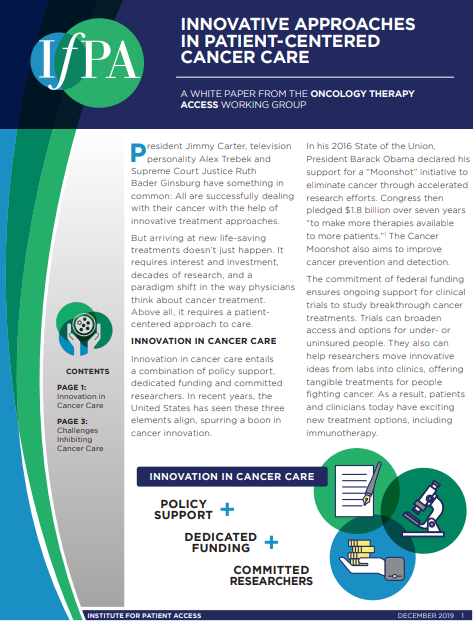Innovation Spurs Need for Patient-Centered Cancer Care
December 17, 2019
Successfully fighting cancer with innovative treatments requires a patient-centered care approach, notes a new white paper from the Alliance for Patient Access’ Oncology Therapy Access Working Group. But for more people to do the same, policy needs to enable a more patient-centered approach to care.
Titled “Innovative Approaches in Patient-Centered Cancer Care,” the paper walks readers forward from President Barack Obama’s Cancer “Moonshot” announcement, highlighting new treatment options and approaches.
Immunotherapy is top among the breakthroughs highlighted in the paper. It has “changed the paradigm for cancer patients” by harnessing the body’s immune system to fight cancer, the paper explains. One specific type of immunotherapy, CAR T-cell therapy, extracts, alters, then infuses patients’ own cells back into their body. The revolutionary approach has been successful for treating several types of cancer and shows promise in treating more.
The paper also discusses the value of precision medicine. The approach involves evaluating the genetic change of each patient’s tumor along with that person’s health history, lifestyle and comorbidities to develop a personalized treatment approach. Precision medicine requires deviating from traditional clinical pathways, where a specific cancer type dictates a specific treatment approach.
Challenges, however, inhibit the delivery of both innovative medicines and innovative approaches. The white paper identifies four common barriers:
- Clinical Pathways. The increased demand for patient-centered care has more physicians making treatment recommendations that veer from the historic one-size-fits-all approach. Despite the potential benefit to patients, health plans may derail physicians’ efforts through the use of utilization management barriers such as prior authorization and step therapy.
- Diagnostic Testing. Physicians may order full genomic sequencing or a couple types of biopsies in an attempt to “gain a comprehensive picture of their patient’s situation.” Regardless, insurers are known for covering only limited testing, if any at all.
- Reimbursement. “Reimbursement becomes a matter of treatment access,” the paper states. Without adequate payment, facilities simply can’t offer innovative treatments – and patients go without.
- Cost Sharing. For many patients, particularly seniors, access to innovative diagnostics and treatments comes down to what they can afford. Patients’ out-of-pocket costs, rather than what’s medically most appropriate, can dictate which approach they take.
These barriers, ironically, keep many cancer patients from realizing the benefit of years – and billions of dollars’ – of research and investment. “The future of cancer treatment is promising,” the paper concludes, but only if policymakers and health plans make patient-centered care more broadly available.
To learn more, read “Innovative Approaches in Patient-Centered Cancer Care.”
Categorized in: Blog


